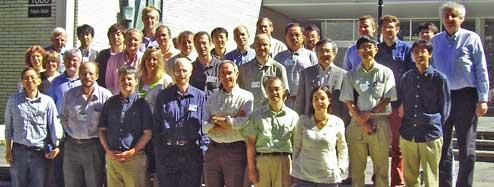
For the 4 days of July 29 through August 2, 2007, TRIUMF hosted the Sixth Circum-Pan-Pacific Symposium on High Energy Spin Physics (PACSPIN). This conference occurs every two years and reviews recent progress in understanding the internal structure of the proton, particularly with respect to the correlations between the spin of the proton and those of its constituent partons, as well as their orbital angular momenta. The strong force that binds protons and neutrons together into atomic nuclei is believed to be described by the theory of quantum chromodynamics (QCD), in which the role of spin is essential. While the “rules” of this theory can be expressed concisely, their consequences are rich and often unexpected, and teach us much about how to understand and describe nature at the subatomic scale.
Experimental information about this issue is obtained from high-energy lepton-proton or proton-proton scattering, where one or both of these particles are spin-polarized. For the last 15 years, scientists at TRIUMF have played a leading role in one of the key experimental projects in this field, participating in a series of measurements at the HERA high-energy electron storage ring at the DESY laboratory in Hamburg, Germany.
This year’s conference attracted scientists from not only Pacific Rim countries, but also from Europe. They presented new experimental results from measurements at DESY, CERN in Geneva, Jefferson Laboratory in Virginia, and the RHIC proton-proton collider at Brookhaven National laboratory on Long Island.
One of the featured results was the determination of the correlation between the proton spin and that of gluons in the proton, which is challenging because the neutral gluons do not experience the electromagnetic force whereby charged lepton beams more readily probe quarks in the proton. Processes in which the gluon first “splits” into a quark-antiquark pair are exploited, one of which then interacts with the beam lepton.
The new results suggest that the gluon polarization is small and contributes little to the total spin-1/2 of the proton. As only a modest proportion is also contributed by the quark spins, as already determined by previous measurements of Deep-Inelastic Scattering (DIS) of leptons (of which the measurements at Hamburg are the most precise at the moment), this leaves the question of the contribution of parton orbital angular momenta.
Dramatic theoretical progress in the last decade has revealed a means of probing this elusive quantity. Hard exclusive processes, especially Deeply Virtual Compton Scattering, is now known to constrain Jq, the total angular momentum of quark flavour q. New data were presented from both DESY and Jefferson laboratory that provide the first such constraints. Although the interpretation of these data is presently strongly model-dependent, they suggest that orbital angular momenta of partons play an important role.
Perhaps the area that received the most attention at the conference was the study of single-spin asymmetries. These have recently assumed great importance for two separate reasons. First, they offer the only possibility in the next decade to determine a fundamental property of quarks in the proton called transversity, which relates to the correlation between the polarization of the quarks and that of the nucleon, in the direction transverse to the momentum of the proton, in a reference frame in which the proton is moving with a momentum very large compared to its mass.
Perhaps the topic that received the most attention at the conference was the study of single-spin asymmetries. Presentation of the latest data and their analyses focused on two key issues. First, measurements of DIS asymmetries with respect to transverse target polarization have recently provided the first experimental information on a fundamental property of quarks in the proton called transversity, which relates to the correlation between the polarization of the quarks and that of the nucleon, in the direction transverse to the momentum of the proton, in a reference frame in which the proton is moving with a momentum very large compared to its mass. Second, such DIS data have also been analyzed to extract a quantity that relates the polarization of the proton to the intrinsic transverse momenta of the quarks. This quantity has an exotic property related to the fundamental time symmetry of QCD, leading to the prediction that it will appear with the opposite sign when measured in the Drell-Yan process of quark-antiquark annihilation in proton-(anti)proton collisions. Future such measurements at RHIC or possibly a new laboratory at Darmstadt in Germany are therefore anticipated eagerly.
On the evening of August 1st, the participants enjoyed a banquet in a room overlooking the fireworks competition called the Symphony of Fire, which is held every summer in English Bay, Vancouver.
